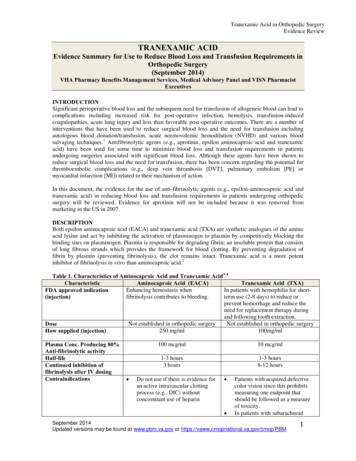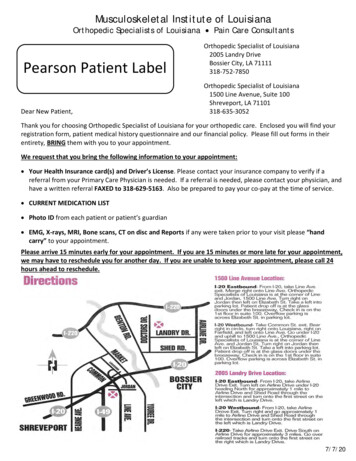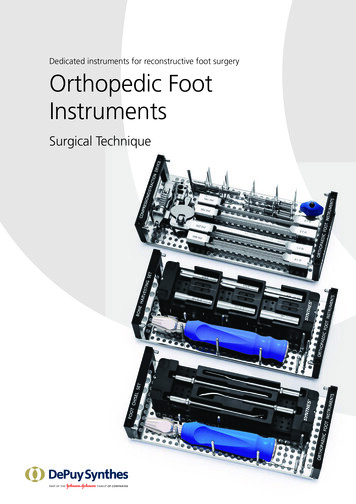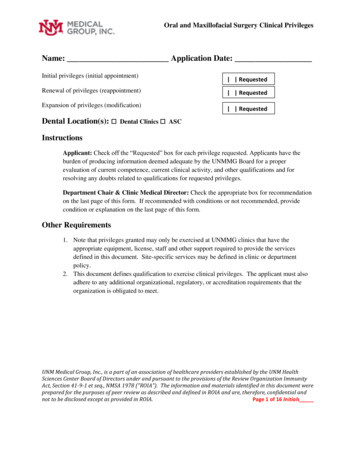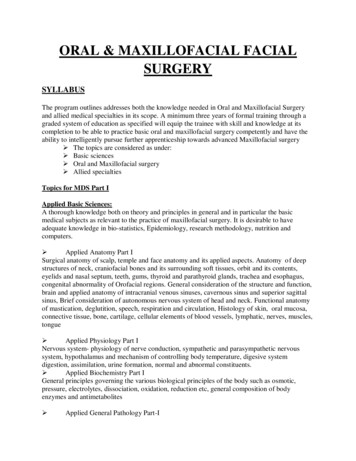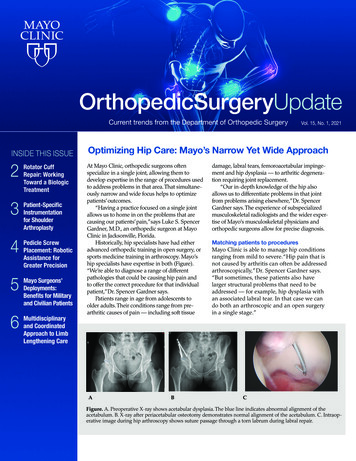
Transcription
OrthopedicSurgeryUpdateCurrent trends from the Department of Orthopedic SurgeryINSIDE THIS ISSUE23456Rotator CuffRepair: WorkingToward a r ShoulderArthroplastyPedicle ScrewPlacement: RoboticAssistance forGreater PrecisionMayo Surgeons’Deployments:Benefits for Militaryand Civilian PatientsMultidisciplinaryand CoordinatedApproach to LimbLengthening CareVol. 15, No. 1, 2021Optimizing Hip Care: Mayo’s Narrow Yet Wide ApproachAt Mayo Clinic, orthopedic surgeons oftenspecialize in a single joint, allowing them todevelop expertise in the range of procedures usedto address problems in that area. That simultaneously narrow and wide focus helps to optimizepatients’ outcomes.“Having a practice focused on a single jointallows us to home in on the problems that arecausing our patients’ pain,”says Luke S. SpencerGardner, M.D., an orthopedic surgeon at MayoClinic in Jacksonville, Florida.Historically, hip specialists have had eitheradvanced orthopedic training in open surgery, orsports medicine training in arthroscopy. Mayo’ship specialists have expertise in both (Figure).“We’re able to diagnose a range of differentpathologies that could be causing hip pain andto offer the correct procedure for that individualpatient,” Dr. Spencer Gardner says.Patients range in age from adolescents toolder adults. Their conditions range from prearthritic causes of pain — including soft tissuedamage, labral tears, femoroacetabular impingement and hip dysplasia — to arthritic degeneration requiring joint replacement.“Our in-depth knowledge of the hip alsoallows us to differentiate problems in that jointfrom problems arising elsewhere,”Dr. SpencerGardner says. The experience of subspecializedmusculoskeletal radiologists and the wider expertise of Mayo’s musculoskeletal physicians andorthopedic surgeons allow for precise diagnosis.Matching patients to proceduresMayo Clinic is able to manage hip conditionsranging from mild to severe. “Hip pain that isnot caused by arthritis can often be addressedarthroscopically,” Dr. Spencer Gardner says.“But sometimes, these patients also havelarger structural problems that need to beaddressed — for example, hip dysplasia withan associated labral tear. In that case we cando both an arthroscopic and an open surgeryin a single stage.”AABCFigure. A. Preoperative X-ray shows acetabular dysplasia. The blue line indicates abnormal alignment of theacetabulum. B. X-ray after periacetabular osteotomy demonstrates normal alignment of the acetabulum. C. Intraoperative image during hip arthroscopy shows suture passage through a torn labrum during labral repair.
Luke S. Spencer Gardner,M.D.In addition to avoiding a second round ofanesthesia and postoperative recovery, a combinedprocedure can improve outcomes.“You get bettervisualization of a labral tear arthroscopically, whichallows you to repair the labrum with less dissection than would be possible with an open surgicalapproach,”Dr. Spencer Gardner says.“Being facilein both arthroscopic and open surgery allows usin a single stage to address each part of a patient’spathology in the optimal manner.”For all patients with hip conditions, Mayo canprovide specialized physical and occupationaltherapy to aid in the recovery process.Continuous improvement is a cornerstoneof Mayo Clinic’s approach to care. A study ofoutcomes from combined open and arthroscopicorthopedic procedures at Mayo Clinic is underway.“The keys to good surgical outcomes aremaking the right diagnosis, performing theprocedure that appropriately addresses thatindividual patient’s problems and providing ahigh level of ongoing care,”Dr. Spencer Gardnersays.“At Mayo, we are committed to every one ofthese stages because ultimately they translate toimproved patient outcomes.”Rotator Cuff Repair: Working Towarda Biologic TreatmentJohn M. Tokish, M.D.2Despite recent improvements in surgical techniquesprovide the necessary biochemical environment toand materials, approximately 25% of rotator cuffget that tendon to regenerate. That used to be scienceinjuries fail to heal. Mayo Clinic is pursuing afiction. But for now, at least in the lab, it’s reality.”regenerative medicine approach for improvedtreatment of these debilitating injuries.Promoting tendon healing and regeneration“We have come a long way over the last 20 years Electrospinning is used to create fibers that, likefrom a mechanical engineering standpoint, witha tendon’s fibers, are measured on the nanolevel.new kinds of anchors,The fibers can be arranged insuture materials andvarying directions.surgical techniques.“We know that the ability ofBut now we’re realizingtissues to regenerate often dependsthat the problem isn’ton the direction of their fibers,”mechanical — it’sDr. Tokish says. “Electrospinningbiologic,” says Johnallows us to place materials that areM. Tokish, M.D., ancommonly used, and biologicallyorthopedic surgeon ataccepted, within a magnetic field.Mayo Clinic's campus inDepending on the magnet’s fieldScottsdale, Arizona.strength and the direction of itsMayo’s Center forspin, we can create nanofibers toRegenerative Medicinebe layered parallel to each otheris working to developor intersecting, or really in anyelectrospun fibers that,shape and direction we want. Inwhen surgically inserted,the laboratory we can use a numbercan promote tendonof these different complementaryhealing. Having createdfields to create a structure thatfiber structures in themimics the native tendon.”laboratory that mimicVarious combinations of fibersthe native tendon, theare being tested in rat modelsresearchers are usingdeveloped in conjunction withanimal models toArizona State University. Beforeinvestigate ways to embedinsertion into the models, the fibergrowth factor products inpatches are imbued with variousFigure. Photograph of a laboratorythose patches (Figure).growth factor products.model shows Mayo Clinic’s experi“Because of the“What’s really exciting is thatmental rotator cuff reconstructionusing an electrospun patch.orthobiologics revolution,we can pre-soak the patch in factorswe’re beginning tocomplementary to the individualunderstand the basic science behind what exactlytendon zones that we need,” Dr. Tokish says. “If it’ssignals a tendon to heal,” Dr. Tokish says. “We’vemuscle, we can embed factors that promote musclelearned that we can add adjunctive materials thatgrowth in that area of the patch. If it’s the calcifiedMAYO CLINIC OrthopedicSurgeryUpdate
cartilage layer on the bone, we can embed factors thatencourage that sort of regeneration into that portionof the patch.”In addition to providing necessary growthfactors, the adjunctive materials may well be ableto change the tendon’s biochemical environment.“We’ve learned that these materials can encouragethe body’s own medicinal signaling cells to berecruited to the area of injury or degenerative tearingand provide the necessary environment for thetendon to regenerate,” Dr. Tokish says. “When weare eventually able to insert the patch into humanpatients, it may act as a scaffold to encourage notonly healing but also regeneration.”The goal is to apply the system to the treatmentof both irreparable tears and severe tendinopathy.“In patients with irreparable tears, the patch byitself or in conjunction with other technologieswe currently use may help that new tendon to beincorporated in the body and patients to regainprevious function,” Dr. Tokish says.For patients with severely damaged yetrepairable tendons, the biologic system might boosthealing and safeguard the surgical repair. “We seea lot of patients in the younger demographic —between the ages of 40 and 60 — who have largerotator tears that are difficult to heal. Unfortunately,the reverse shoulder arthroplasty, which hasrevolutionized care for older patients, isn’t a goodoption for younger people,” Dr. Tokish says. “Weare some ways away yet from human trials. But wefeel that augmenting tendon healing through theregenerative medicine field may be the missing keythat will help us to better treat rotator cuff tears.”Patient-Specific Instrumentation forShoulder ArthroplastyMayo Clinic uses the latest technology for shoulderreplacement surgery, including analytical tools thatprovide understanding of an individual patient’sglenoid wear pattern. Sophisticated preoperativeplanning and the use of patient-specific instrumentation are key to optimizing glenoid component choiceand position and maximizing surgical outcomes.“We’ve learned over time that understandingthe glenoid bone’s three-dimensional anatomy isenormously helpful in planning shoulder replacement surgery,” says John W. Sperling, M.D., anorthopedic surgeon at Mayo Clinic in Rochester,Minnesota. “These tools allow us to develop a surgical plan based on the individual patient’s anatomyand then to accurately execute that plan once we getto the operating room.”With the highest-volume shoulder replacementpractice in the United States, Mayo Clinic is at theforefront of advances in this complex procedure. Inaddition to implementing 3D surgical guides based onan individual patient’s anatomy, Mayo’s orthopedicsurgeons use recently developed depth controls forglenoid reaming (Figure 1).John W. Sperling, M.D.Figure 1. On the left, photograph shows a 3D glenoid model with a patient-specific guide. In the center,perioperative photograph shows the patient-specific guide matching the patient’s glenoid surface. Onthe right, perioperative photograph shows a depth control guide for glenoid reaming, to maximize thepreservation of glenoid bone.Figure 2. Perioperative photographs showthe use of an augmented glenoid baseplate. On the left, an augmented glenoidbaseplate is placed in a patient. On theright, the augmented baseplate’s abilityto create tilt and provide lateralization aredemonstrated.MAYO CLINIC OrthopedicSurgeryUpdate3
“A 3D-printed guide attached to the reamerallows for precise preparation of the glenoid surfaceand maximizes glenoid bone preservation,” Dr.Sperling says. “During surgery, the depth controlhelps us prepare the glenoid in the manner that weplanned preoperatively.”Initially, patient-specific instrumentation wasreserved for patients with complex anatomy, including dysplasia, bone deficiency or deformity secondary to prior trauma. “But due to the benefits we’veseen, we are broadening our use to the full rangeof conditions, from minimal glenoid deformity tohighly complex underlying shoulder pathologies,”Dr. Sperling says.Mayo Clinic’s team approach facilitates thisindividualized orthopedic care. The CT scansneeded for pre-surgical planning and patient-specific instrumentation can be pre-scheduled to coordinate with surgical and medical appointments.“The patient experience here is very time efficient,”Dr. Sperling says.The CT scans are uploaded to a system thatuses advanced software to allow the surgeon toplan the orthopedic procedure and order patientspecific surgical guides. “In the operating room, thepreoperative plan and patient-specific instrumentation increase the procedure’s efficiency,” Dr. Sperlingsays. “We can execute our plan to preserve bone andoptimize the positioning of the implant.”Augmented baseplate for reverse shoulderarthroplastyTo preserve glenoid bone in patients who havereverse shoulder arthroplasty, Dr. Sperling uses anaugmented glenoid baseplate (Figure 2, see page 3).“The augmented component minimizes boneremoval compared with eccentric reaming, preservesthe best-quality cortical bone and allows for longerscrew fixation,” Dr. Sperling says. “Recent researchhas shown that the routine use of augmented baseplates in reverse arthroplasty, along with preoperative planning, can result in over 50% preservation ofglenoid bone compared with the use of a standardglenoid baseplate.”As the major shoulder arthroplasty center in theUnited States, Mayo Clinic is committed to continuedinnovation. “In the future, as preoperative planning and patient-specific instrumentation continueto evolve, we will be able to further customize ourprocedures for individual patients,” Dr. Sperling says.Pedicle Screw Placement: Robotic Assistancefor Greater PrecisionAccurate placement of pedicle screws is key toavoiding the potential complications of spinalfusion surgery and improving overall spinal fixation. Mayo Clinic uses the latest robot-assistedtechnology when indicated to enhance surgicalprecision in these procedures (Figure).“Robot-guided surgery is a well-choreographed process that can help ensure reliableand accurate placement of spinal implants,” saysBrett A. Freedman, M.D., an orthopedic surgeonat Mayo Clinic in Rochester, Minnesota. “Wefind that this system offers distinct advantagesFigure. Mohamad Bydon, M.D., a neurosurgeon at Mayo Clinic inRochester, Minnesota, leads a team performing spinal surgery usingnew robot-guided technology.4MAYO CLINIC OrthopedicSurgeryUpdatecompared with not only freehand placement butalso standard stereotactic navigation.”Mayo Clinic was an early adopter of robotassisted technology for spinal fusion surgery. As anorthopedic center of excellence, Mayo is committedto new technology that provides clinical benefitsand adds value. “Robot-assisted surgery is just oneexample,” Dr. Freedman says. “We continually lookfor validated innovations that help our patients.”Ideal paths and trajectoriesRobot-assisted spine surgery uses CT imaging andnavigational software to determine the optimalpathway for inserting pedicle screws. Finding thatpathway is made challenging by the lack of clearance around the spine and the presence of surrounding neurological structures.“Robotic assistance gives us real-time imagingthat reliably depicts complex anatomy,” Dr. Freedman says. “That’s very important when a patient hasnot only deformity that changes the shape of bonebut also poor-quality bone. We can actually find apath that goes through the patient’s best bone asopposed to softer bone.”During surgery, the system’s software guidesthe robotic arm into position, translating the surgical plan onto the surgical field. “The robotic arm
places the guidance tube in the preferred alignment,and each screw can then be placed to a depth and inan alignment that matches its mates, which makesfor a better overall construct,” Dr. Freedman says. “Asystem that robotically aligns the screws’ trajectoriesmakes it easier to insert the spinal rods and inducesless stress on the screws we placed.”In addition, the robotic arm’s stability overcomesproblems inherent with standard stereotactic navigation. “Stereotactic navigation requires the surgeon’shands to be held in a specific position that is mappedto the imaging. However, our hands move — especially when we are preparing and inserting screws— while the robot holds a rock-steady trajectory,”Dr. Freedman says. “Our arms and other appendages are also in the way of the tracking camera thatwatches the various surgical instruments move. Therobot-assisted system gives us an enhanced path ofnavigation.”Mayo Clinic continuously assesses new technologies to determine their benefits for patients.“As spine surgeons, we want to innovate to solveproblems, validate these solutions, and research theimpact they have on clinical outcomes and valuebased care,” Dr. Freedman says. “Robotic assistanceoffers real advantages for the accurate placement ofpedicle screws.”Brett A. Freedman, M.D.Mayo Surgeons’ Deployments: Benefitsfor Military and Civilian PatientsA sizable number of Mayo Clinic’s orthopedicsurgeons are active duty veterans or reservistswho have been deployed overseas. Mayo’s militaryconnections serve not only members of the armedforces but also civilian patients once the surgeonsreturn to Mayo.“The acuity of injuries we see at Mayo, and ourpatient volumes, make us well prepared for deployment. We also can take new techniques from ourmilitary experience back home,” says NicholasA. Pulos, M.D., a hand surgeon at Mayo Clinic inRochester, Minnesota, who recently returned fromdeployment to Kandahar, Afghanistan.Figure. Photograph shows the hand of a woundedserviceman following treatment in Afghanistan byNicholas A. Pulos, M.D., a Mayo Clinic hand surgeonon deployment with the United States Navy Reserve.A blasting cap injury had mutilated the hand. Working with military colleagues, Dr. Pulos harvested agroin flap to cover the palmar defect.Mayo’s ties to military service stretch back toDr. William Worrall Mayo, who began his medicalpractice in Rochester in 1864 as an examining physician for Civil War enlistees. Dr. Pulos, who servesin the United States Navy Reserve, notes that handsurgery emerged as a medical specialty after WorldWar II due to the wartime need for reconstructivesurgeries. In addition to hand surgeons, orthopedicsurgeons at Mayo Clinic specializing in the spineand hip, as well as plastic surgeons and otherspecialists, have military experience.As a salaried organization with a strong founding culture, Mayo Clinic pursues a team-basedapproach to care. “We put our patients’ interestsfirst and work together as a team rather than asindividuals to deliver the care they need,” saysBrett A. Freedman, M.D., an orthopedic surgeonat Mayo’s campus in Minnesota, and a decoratedUnited States Army veteran. “We take our Mayovalues with us on deployment, and they blendperfectly well with the military.”With a large orthopedic practice, Mayo Cliniccan transition patients to care from other experienced specialists when staff are deployed. “Eventhough all Mayo employees aren’t able to servein a combat zone, they do contribute by helpingtheir colleagues and families while the deployedphysicians are overseas,” says Paul M. Huddleston, M.D., an orthopedic surgeon at Mayo’scampus in Minnesota and a decorated UnitedStates Arm veteran who has served severaldeployments in Iraq and Afghanistan.“Mayo is very supportive of deployment,”Dr. Pulos adds. “As an all-volunteer force, themilitary relies on reservists, including physiciansat Mayo Clinic, to go out on active duty and helpservice members.”Nicholas A. Pulos, M.D.MAYO CLINIC OrthopedicSurgeryUpdate5
Trauma-related expertisePaul M. Huddleston, M.D.Peter C. Rhee, D.O.Improved body armor has helped service personnel survive injuries that might have been fatal inprevious conflicts. “A lot of the injuries we see ondeployment involve the extremities because the bodyarmor is so good,” Dr. Pulos says. “About 50% of thesurgeries I did in Afghanistan involved the hand.”Mayo Clinic has a sizable orthopedic traumapractice. “The Mayo expertise is really helpful inthinking of creative ways to do orthoplastics (Figure, see page 5) on deployment,” Dr. Pulos says.“We have experience using regional flaps and softtissue transfers to reconstruct upper extremitiesafter traumatic injuries.”That expertise facilitates immediate definitivetreatment for service members. “Typically, servicemembers with serious injuries in Afghanistan arestabilized and then sent back to the United States,”says Peter C. Rhee, D.O., a hand surgeon at Mayo’scampus in Minnesota and a United States Air Forcereservist. “Military physicians are very skilled. Butfor a majority of trauma-related injuries out there,the Mayo surgeon may be the only person who canprovide definitive treatment.”That capability is especially beneficial for localcitizens who become injured while helping the UnitedStates military. “We can’t send those local nationals tothe United States for care,” Dr. Rhee says. “But thosepatients can have a Mayo Clinic-trained surgeon, inthe most austere environment, where normally theywouldn’t have access to any surgeon.”At the same time, Mayo’s surgeons learn newskills on deployment that can ultimately benefitpatients back in the United States. Dr. Pulos cites themilitary’s use of perioperative tranexamic acid andtourniquets to control bleeding.“Tourniquets weren’t as popular in civilian practice,” he says. “But their use in militarypractice has trickled down to medical practice inthe civilian sector.”Mayo Clinic physicians have also publishedextensively on the orthopedic issues encounteredon deployment. “As military surgeons, our workcontributes to knowledge of lifesaving developments supporting the war effort,” Dr. Huddlestonsays. “Our experience with combat-related spinalfractures and injuries helps us understand and treatthese issues today.”Dr. Freedman’s military service led to publishedresearch on topics including spinal care, compartmentsyndrome diagnosis and wound healing. As a firstyear resident at Walter Reed Army Medical Center,he was motivated by the traumatic injuries he saw inPentagon personnel after the attack on Sept. 11, 2001,and in soldiers and sailors who returned from warwith catastrophic spine and limb injuries.“The extremity injuries we have seen in wartoday have really pushed the envelope,” he says.“The use of biologics and enhanced methods ofbone healing, and the development of new implantsand wound care devices all owe something to thoseexperiences. We are always looking to innovate andfind a better way.”Dr. Freedman notes that Mayo Clinic is exploring further ties with the military through a programthat would bring military medical personnel to aMayo campus to work alongside Mayo specialists.“The idea is to give the military personnel the Mayoexperience,” he says. “The benefits for Mayo and themilitary are definitely bidirectional. As Mayo surgeons, we give to the military but we also take backthe experience of how a team can work togetherin an austere location when you don’t have all theresources you want.”Multidisciplinary and Coordinated Approachto Limb Lengthening CareStephen (Andy) A. Sems,M.D.6The causes of limb deformities are variable andoften complex. Mayo Clinic’s Limb Lengthening andRegeneration Clinic in Minnesota takes a multidisciplinary approach aimed at maximizing functionwhile managing any underlying disorders.“Many of these patients require attention frommore than just an orthopedic surgeon, because manylimb deformities involve more than just bone. Accessto the resources of multiple specialists in multiplefields is really beneficial,” says Stephen (Andy) A.Sems, M.D., an orthopedic surgeon at Mayo Clinic inRochester, Minnesota.MAYO CLINIC OrthopedicSurgeryUpdateManaging care for both children and adults, thelimb lengthening clinic brings together experts inseveral orthopedic surgery subspecialties, includingorthopedic trauma, pediatric orthopedics and orthopedic oncology. Plastic and reconstructive surgeons,medical geneticists, endocrinologists and radiologistsalso are part of the team. Individualized treatmentrecommendations are made based on the combinedinput of all team members. The treatment options areas varied as the sources of the deformities (Figure, seepage 7), and external or internal fixation can be provided, depending on the individual patient’s needs.
BACFigure. X-rays illustrate the treatment of a 55-year-old woman with Ollier’s disease at Mayo Clinic’sLimb Lengthening and Regeneration Clinic in Minnesota. A and B. The patient presented with leftknee pain, bilateral deformities of the lower extremities including the right foot and ankle, and leglength discrepancy. A foot and ankle specialist, an orthopedic oncologist, and an orthopedic limbdeformity specialist worked together to coordinate her surgical treatment. C. She was treated with leftfemoral and tibial osteotomies using intramedullary nail fixation of the femur and multiplanar ringfixation of the tibia, followed by right tibial lengthening and right hindfoot osteotomy and fusion.The patient experienceMayo requests referring physicians to send as muchinformation as possible about patients before theyare seen at the limb lengthening clinic. “We gathera group of specialists, based on a patient’s individualsituation, to review that information,” Dr. Sems says.“We then try to set up a flow of consultations withindividual specialists, to minimize the patient’s tripsto Mayo.”For example, a patient with an underlying metabolic disorder would see an endocrinologist as well asvarious surgeons. “The limb deformity might requiresoft tissue procedures, such as flaps or nerve releases,which would need the involvement of a microvascular surgeon,” Dr. Sems says. “Depending on wherethe deformity occurs, we have foot and ankle surgeons, and hand and upper extremity surgeons. If thedeformity involves a residual amputation, we have aspecialist with experience in those conditions.”Each of these specialists routinely sees patients inthe limb lengthening clinic. Having a core group ofspecialists helps ensure that the team has experiencewith patients’ varied conditions, even rare disorders.“We don’t just put in a referral to endocrinology. For example, there are two endocrinologists wetypically work with, along with two specific handsurgeons, one foot and ankle surgeon, two pediatricsurgeons, and one geneticist,” Dr. Sems says. “Ourfamiliarity with one another creates a sense of teamwork and an understanding of these patients.”As a major tertiary center, Mayo Clinic offers thefull range of treatment options. These include lengthening rods, external fixation, and other implantabledevices made from metals or polyether ether ketone(PEEK) polymers that can change limb angles.“New technology has revolutionized how limblengthening is approached,” Dr. Sems says. “Manyof our patients tell us after treatment that this is thefirst time they’ve had a functioning or well-alignedlimb in as long as they can remember. Allowing oursurgeons to focus on their areas of expertise contributes to giving patients the best possible outcomes.”For more informationLimb Lengthening and Regeneration Clinic inMinnesota. Mayo /overview/ovc-20472088.MAYO CLINIC OrthopedicSurgeryUpdate7
MAYO CLINICOrthopedic Surgery UpdateMedical Editor:John W. Sperling, M.D.Education OpportunitiesMayo Clinic Orthopedic Surgery Update is written forphysicians and should be relied upon for medicaleducation purposes only. It does not provide acomplete overview of the topics covered and shouldnot replace the independent judgment of a physicianabout the appropriateness or risks of a procedurefor a given patient.Contact UsMayo Clinic welcomes inquiries and referrals,and a request to a specific physician is notrequired to refer a patient.Phoenix/Scottsdale, Arizona866-629-6362 (toll-free)Jacksonville, Florida800-634-1417 (toll-free)Rochester,Minnesota800-533-1564 (toll-free)ResourcesFor more information or to register for courses, visit https://ce.mayo.edu/group/orthopedic-surgery,call 800-323-2688 (toll-free) or email cme@mayo.edu.Controversies in Wrist Surgery 2021 and Pre-Conference Advanced Wrist Arthroscopy LabApril 22-25, 2021This course is designed for orthopedic and plastic surgeons with significant hand practices, and covers thespectrum of disorders of the wrist and distal radioulnar joint. The format will be case oriented, covering topicsin areas including bony and soft tissue trauma, degenerative disease, and inflammatory arthritis. Videotapedsurgery clips and cadaveric surgical dissection will be used to demonstrate complicated surgical procedures.Orthopedic Infectious Diseases — LIVESTREAMMay 21-22, 2021Designed for infectious disease practitioners, this course is dedicated entirely to the challenges of managingorthopedic infections. It will feature highly interactive, case-based modules delivered by subject matterexperts addressing diagnostic and therapeutic challenges.9th Annual Comprehensive Sports Medicine Update and Board Review 2021June 16-19, 2021This award-winning course provides a comprehensive review of all subjects contained in the sports medicineboard examination. The faculty includes internationally recognized experts in the field of sports medicine.30th Annual Mayo Clinic Symposium on Sports Medicine — 2021Nov. 5-6, 2021This course features evidence-based and cutting-edge diagnostic and treatment strategies for sports-relatedand musculoskeletal conditions. The program is multidisciplinary, with expert lecturers representing aspectrum of sports medicine l trials, CME, Grand Rounds,scientific videos and online referralsMC6247-0121
Gardner, M.D., an orthopedic surgeon at Mayo Clinic in Jacksonville, Florida. Historically, hip specialists have had either advanced orthopedic training in open surgery, or sports medicine training in arthroscopy. Mayo's hip specialists have expertise in both (Figure). "We're able to diagnose a range of different
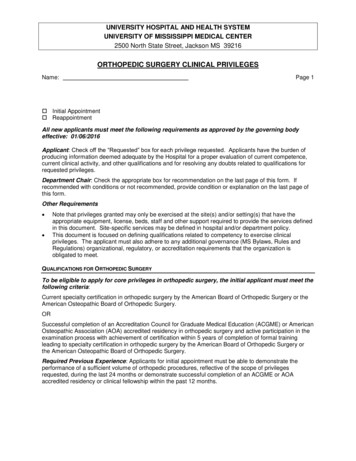

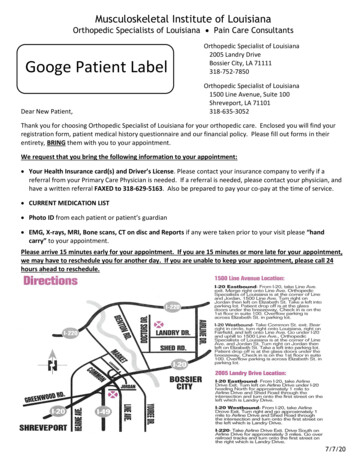
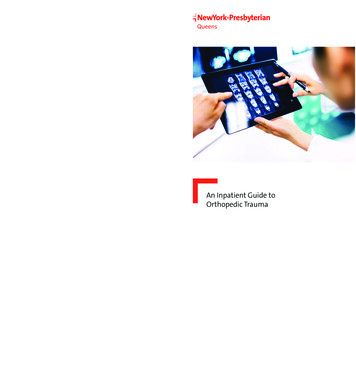
![[VERIFIED] Siemens Tia Portal V11 Crack 49 8](/img/66/olwder.jpg)
